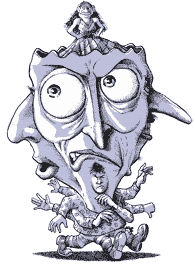Via Ldragoon, an essay by Julia Serano, “Skirt Chasers: Why the Media Depicts the Trans Revolution in Lipstick and Heels.” The essay is long and all of it is excellent, which makes picking a few sample paragraphs while doing justice to the piece impossible. But I’m a blogger, and that’s what I do, so:
Media depictions of trans women, whether they take the form of fictional characters or actual people, usually fall under one of two main archetypes: the “deceptive” transsexual or the “pathetic” transsexual. While characters of both models have an interest in achieving an ultrafeminine appearance, they differ in their abilities to pull it off. Because the “deceivers” successfully pass as women, they generally act as unexpected plot twists, or play the role of sexual predators who fool innocent straight guys into falling for “men.” [..]
Even though “deceivers” successfully pass as women, and are often played by female actors (with the notable exception of Jaye Davidson as Dil), these characters are never intended to challenge our assumptions about gender itself. On the contrary, they are positioned as “fake” women, and their secret trans status is revealed in a dramatic “moment of truth”. At the moment of exposure, the “deceiver’s” appearance (her femaleness) is reduced to mere illusion, and her secret (her maleness) becomes the real identity. […]
In virtually all depictions of trans women, whether real or fictional, “deceptive” or “pathetic”, the underlying assumption is that the trans woman wants to achieve a stereotypically feminine appearance and gender role. The possibility that trans women are even capable of making a distinction between identifying as female and wanting to cultivate a hyperfeminine image is never raised. In fact, the media often dwells on the specifics of the feminization process, showing trans women in the act of “putting on” their feminine exteriors. It’s telling that TV, film, and news producers tend not to be satisfied with merely showing trans women wearing feminine clothes and makeup. Rather, it is their intent to capture trans women in the act of putting on lipstick, dresses, and high heels, thereby making it clear to the audience that the trans woman’s femaleness is an artificial mask or costume. […]
What always goes unseen are the great lengths to which producers will go to depict lurid and superficial scenes in which trans women get all dolled up in pretty clothes and cosmetics. Shawna Virago, a San Francisco trans activist, musician, and codirector of the TrannyFest film festival, has experienced several such incidents with local news producers. For instance, when Virago was organizing a forum to facilitate communication between police and the trans community, a newspaper reporter approached her and other transgender activists for an article. However, the paper was interested not in their politics but in their transitions: “They wanted each of us to include ‘before’ and ‘after’ pictures. This pissed me off, and I tried to explain to the writer that the before-and-after stuff had nothing to do with police abuse and other issues, like trans women and HIV, but he didn’t get it. So I was cut from the piece.” […]
When audiences watch scenes of trans women putting on skirts and makeup, they are not necessarily seeing a reflection of the values of those trans women; they are witnessing the TV, film, and news producers’ obsession with all objects commonly associated with female sexuality. In other words, the media’s and audience’s fascination with the feminization of trans women is a by-product of their sexualization of all women.
The entire essay includes a discussion of the invisibility of trans men in media depictions of transsexuals, and a critique of the essentialism and sexism of Janice Raymond style anti-trans views within feminism. It’s worth reading the whole thing.
The essay was later incorporated into Serano’s book Whipping Girl, which I haven’t read but now really want to.



I wish I’d read that essay before I agreed to be photographed by some glossy magazine. It was British, but it’s interesting how ftm images are presented more and more and fit within a similar classification system. And by “interesting” I mean “a learning experience.” Anything that wants a “before” picture is shite shite shite.
That essay is so awesome. I can’t comment on it much here, now, because I want to read it again later, take notes, and post the comments I have and a link to it on my blog which will confuse the hell out of the people who read my blog.
The things that confuses me the most is how some feminists, queer people and women’s rights people do not support trans-people. How can they not? It just always seems part of the package to me. I’m not all up on the issues and the language appropriate and so one, but if someone says they’re a woman or a man, I’m happy to accept that and use the appropriate and desired pronoun and consider them that gender. Depending on who they are and how I know them, that may twist my head around, or it may seem completely natural. I’m not sure why some people object so much. Not that I want anyone to tell me why they object to transgendered people, because I’ve been reading a lot about prejudice and “isms” lately, and I’m kinda all out of energy for that kind of thing. And I don’t think anyone “here” would want to hear it in any case.
Anyone who only read the excerpt here, I second Ampersand’s comment that you should read the whole thing. It’s not like a blog entry, it’s a proper essay, and it’s really good.
I was going to write something really witty, but Julia is just hella-awesome.
Have a video. She’s great.
http://www.youtube.com/watch?v=a95JP8i8GuE
The reasons that people use to object to transgender and transsexual people are numerous. Some of the reasons might have merit, if they were limited to the individuals in question, but as Julia points out, the entire trans world is divided into a limited number of categories, all of which suck in the minds of the nonacracy. The better one “does” gender, the more of a tool they are. The better ones doesn’t “do” gender, the more they are pretending not to be a tool, and thereby being a tool.
You want before and after pictures of me getting dressed? Hey, I’ve got a better idea. Howzabout I publish before and after pictures of you getting dressed? I’ll title it, “Ooh, how cute it is when it puts on clothes!”
Whipping Girl is great. It’s the only book on gender issues that I’ve ever read and immediately thought, “I need to read that again. I know I didn’t get all of it.” Just brilliant. If “Inside Out” is still available, get it too. The version I bought had a CD; hearing her speak her pieces is awesome. I just get all fangirl around her stuff. :-)
Not to be too critical, but it seems as if the author of the piece is irked because the popular presentation is not of her experience. Certainly she is entitled to her opinion; just as certainly, one hopes she realizes that all trans women do not share her experience, and that those who do not, be they of the “deceptive” or “pathetic” variety, are no less- and no more- authentic than she.
Whipping Girl is probably the first book on gender with which I’ve identified with in years. It actually represents thoughtful consideration in the matter.
The first part was unfortunately definition-laden; a less than stellar start, but the rest is amazing. Must read & re-read…
Pingback: Alas, a blog » Blog Archive » Transsexuals According To The Mainstrem Media: Either Deceptive or Pathetic